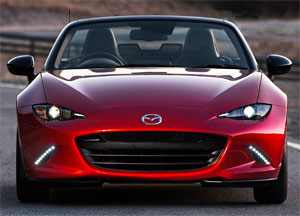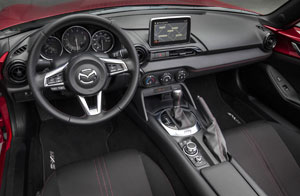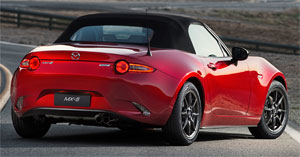2016 Mazda MX-5
For as long as we’ve been testing cars, we’ve yet to come across one that brings as much pure driving joy for the dollar spent as the Mazda Miata roadster. And even though it’s now officially the MX-5, and more and more sophistication has crept into the design over three generations, the all-new 4th gen, 2016 MX-5 keeps the good times rollin’.
It’s hard not to have a good time behind the wheel of the 2016 Mazda MX-5. As while this 4th iteration roadster may no longer look as far back, or be as basic, the pure sports car spirit of the original 1990 Miata is fully intact.
Like most recent Mazda’s, a significant effort is made to take the weight out, despite adding in more creature comforts. Weight is down 150-lbs. to 2,332.
And as before, there’s just enough go from the engine to make things fun, though now it’s the SKYACTIV-G 2.0-liter I4 at 155-horsepower and 148 lb-ft. of torque. A 6-speed manual transmission is standard, and it feels just as good as we remember. A 6-speed auto is available as well, but please only if you must.
At our test track, the MX-5 hops off the line better than ever. And while it’s easy to pine for more power, we’re actually quite happy with the engine’s output. It took 6.8–seconds to reach 60 on a slick track, and 15.4 to complete the ¼ at 89 miles-per-hour.
 When it comes to cone work, the first thing you notice is the new electric power steering. Turn in is still razor sharp and precise, there’s just a very light feel to it now, maybe too light. The car itself however, feels far more solid overall. Still, it’s just as entertaining as ever tossing it around with playful amounts of oversteer.
When it comes to cone work, the first thing you notice is the new electric power steering. Turn in is still razor sharp and precise, there’s just a very light feel to it now, maybe too light. The car itself however, feels far more solid overall. Still, it’s just as entertaining as ever tossing it around with playful amounts of oversteer.
The suspension remains double-wishbone front and multilink rear, but this time around, Club trim includes the sport suspension with Bilstein dampers and a shock tower brace; as well as a limited slip rear.
Averaging 60 MPH stopping distance of just 111–feet means the braking is done with the same no-nonsense efficiency as the rest of the car.
The leaner, meaner MX-5 has a much more modern look of course. It also sits lower, and is a hair wider.
The face is still friendly, but the rest of the car is a little edgier, almost BMW-like, with its Euro-esque sculpted rear. Both head and tail lights are full LEDs with LED DRLs of course.
Club trim adds a sharper-looking front air dam and black side mirrors; while the Brembo/BBS package really spices things up with painted calipers, side sill extensions, rear bumper skirt, and of course 17-inch forged BBS wheels.
True to tradition, a manual soft top is standard, folding and latching easily right from the driver’s seat. No word yet on whether an optional hardtop will return.
 Inside, available features abound, fully displayed here in Club trim, like a dash top 7-inch screen. Touch controls are limited to when you’re sitting still. This Commander Controller is use when moving. Push button start is standard. But the remainder of the interior, from round air vents to big analog gauges is as clean and simple as ever.
Inside, available features abound, fully displayed here in Club trim, like a dash top 7-inch screen. Touch controls are limited to when you’re sitting still. This Commander Controller is use when moving. Push button start is standard. But the remainder of the interior, from round air vents to big analog gauges is as clean and simple as ever.
Most importantly, the shifter falls readily to hand as always, and we quickly felt right at home. More comfortable seats with extra adjustments are always welcome, and they still hold you tight as well.
As for complaints, we understand the need of the Commander Controller, but its console placement is too far back for easy use, and we could use a little more girth to the steering wheel.
Mazda says that the MX-5’s trunk is smaller, but we actually found it more useful than before.
Government Fuel Economy Ratings for the manual are 27-City, 34-Highway, and 30-Combined. Even better are the numbers for the automatic at 27-City, 36-Highway, and 30-Combined. And they both share a great Energy Impact Score of 11.0-barrels of oil used and 4.9-tons of CO2 emissions per year.
 Prices have increased, now starting at $25,735 for Sport trim; this Club, at $29,420, and top shelf Grand Touring at $30,885. Still, no one else offers this much roadster fun for the dollar.
Prices have increased, now starting at $25,735 for Sport trim; this Club, at $29,420, and top shelf Grand Touring at $30,885. Still, no one else offers this much roadster fun for the dollar.
So, back to where we started. Even with all the improvements, Mazda has not compromised that great Miata persona. The 2016 Mazda MX-5 does indeed deliver a lot more than just sports car basics, but those basics are still what this little roadster gets exactly right.
Specifications
- Engine: 2.0 liter I4
- Horsepower: 155
- Torque: 148 lb-ft.
- 0-60 mph: 6.8 seconds
- 1/4 mile: 15.4 seconds @ 89 mph
- EPA: 27 mpg city/ 34 mpg highway
- Energy Impact: 11.0 barrels of oil/yr
- CO2 Emissions: 4.9 tons/yr
2024 Polestar 2
More Range And More Power For The Polestar 2
Volvo is well on their way to making the transition to an all-electric brand, but their sister-brand Polestar is already there. Now, we’ve spent lots of time in their all-wheel drive, five-door Polestar 2, having tested it in 2021, and a year later when a two-wheel drive version arrived. But, EV updates are coming quickly. So, let us be your guide for all that’s new with the Polestar 2.
While we are driving more EVs than ever, we’ve also been spending a lot of time recently circling back to ones we’ve previously tested. As in this new era of electrified vehicles, significant updates are arriving quickly, with R&D investments increasing and retrofitting them easier than ever. This is often done through software updates that can even be accomplished over the air. For 2024, the Polestar 2 has indeed gotten some software updates, but some physical ones as well.
Clearly aimed directly at Tesla’s Model 3 when it arrived; the Polestar 2’s build quality was vastly better, but range definitely came up short. So, addressing that was priority No. 1; and for ’24 the Polestar can travel up to 20% farther than before while consuming 9% less energy, and when it comes time to charge it back up, it can do that 34% faster too.
Range in the Single Motor version increases from a max of 270 to 320 miles thanks to a larger 82-kWh battery pack, and that solitary motor now powers the rear wheels, not the front wheels. It’s also bigger, coming in at 220 kW compared to the previous 170 kW front-wheel drive version, going from 231 to 299 horsepower.
Dual Motors keep the same 78-kWh battery, but still sees a boost from 260 to 276 miles and takes advantage of the larger rear motor for a new combined 310-kW output with 421 horsepower. Our test car has the added Performance Pack, which uses an additional 35 kW to deliver 455 horsepower and 546 lb-ft of torque, though max range drops to just 247 miles.
The new battery in rear-drive 2s will also charge faster, now accepting up to 205 kW for an 80% charge in 20 minutes; max for dual-motors stays at 155 kW, which puts an 80% charge at 34 minutes. Using 32 kWh of electricity per 100 miles, the Dual Motor earns a good efficiency rating.
The [Polestar] 2 has always been one of the most enjoyable EVs to drive, even more so now with that additional power coming from the rear motor.
Unfortunately, extremely cold temperatures kept us from seeing that increased range, as we were only on pace for about 194 miles in our test.
The 2 has always been one of the most enjoyable EVs to drive, even more so now with that additional power coming from the rear motor. And especially when equipped with the Performance Pack as it not only includes more power, but adds 20-inch forged wheels, upgraded brakes, and adjustable Ohlins Dual Flow Valve performance dampers. It greatly improves handling prowess without affecting ride quality, and is easily worth the $5,500 charge if you at all enjoy driving.
Even on a 20-degree track day there was plenty of grip through our handling course. No understeer or oversteer, and lots of feedback through the wheel. There was a nice, strong launch off the line that properly planted us firmly in the seat, and rocketed us to 60 in 4.5 seconds. Power delivery stayed pretty intense up until about 80 mph when there was a definite tapering off. Still, it was a 13.4-second quarter-mile at 102 mph; smooth, quiet, and stable the whole way.
When this car debuted, its Google-based infotainment setup was a novelty, but since then, more and more manufacturers are just “Googling it” so it doesn’t seem out of place at all. The wireless phone charger is easy to access, and there’s a great Harmon/Kardon sound system and panoramic sunroof to enhance the in-cabin experience. Exteriors have also been enhanced with a smooth grille insert and new wheel choices.
Hatchback practicality means 14.3 cu-ft of easy to access cargo space with split-folding seatbacks for longer items and expanding the space to 38.7 cu-ft. Plus, there’s even a sizeable storage bin up front under the hood.
Single Motor Polestar 2 pricing now starts at $51,300, with Dual Motors starting at $56,700; topping out at $64,400.
For a car manufacturer that hasn’t even been around for a decade yet, Polestar has kept itself busy, totally transforming their latest model in just a few years, making the 2024 Polestar 2 even more appealing. They are certainly off to a good start, and with a host of Polestars just over the horizon, including some all-important utility vehicles, this star will be shining even brighter.
Specifications
As Tested
- Motor Setup: Dual Motor
- Horsepower: 455
- 0-60 mph: 4.5 seconds
- EPA Range: 247 miles
- Efficiency : 32 kWh / 100 miles
- Battery Size: 78-kWh
- Torque: 546 lb-ft
- 1/4 Mile: 13.4 seconds at 102 mph
- MW Test Loop: ~ 194 miles
- Peak Charging Rate: 155 kW











































